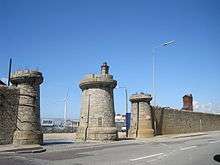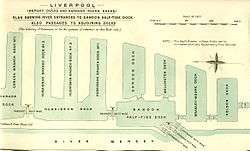Bramley-Moore Dock
| Bramley-Moore Dock | |
|---|---|
 Dock gates on the Dock Road | |
| Location | |
| Location | Vauxhall, Merseyside, United Kingdom |
| Coordinates | 53°25′30″N 3°00′11″W / 53.4250°N 3.0030°WCoordinates: 53°25′30″N 3°00′11″W / 53.4250°N 3.0030°W |
| OS grid | SJ334924 |
| Details | |
| Owner | The Peel Group[1] |
| Operator | Mersey Docks and Harbour Company |
| Opened | 4 August 1848[2] |
| Closed | 1988[3] |
| Type | Wet dock |
| Joins | |
| Area | 9 acres (3.6 ha), 3,106 sq yd (2,597 m2)[4] |
| Width at entrance | 60 ft (18 m)[4] |
| Quay length | 935 yd (855 m)[5] |
Bramley-Moore Dock is a dock on the River Mersey, England, and part of the Port of Liverpool. It is situated in the northern dock system in Vauxhall, connected to Sandon Half Tide Dock to the north and Nelson Dock to the south. It was designed by Jesse Hartley and opened in 1848.
History
The dock was opened on 4 August 1848,[2] as part of Hartley's major northern expansion scheme of that year, and was named after and opened by John Bramley-Moore, Chairman of the dock committee.[1][2] When built, Bramley-Moore Dock was the most northerly part of the dock system.[2] At the time, access to the River Mersey was from the south, through the new Nelson and Salisbury Docks, opened at the same time. When built, Bramley-Moore Dock was used for the largest steamships of the time, although this berthing was moved to Sandon Dock and Huskisson Dock within a few years.[6]
In 1851, further docks were opened to the north. These included Wellington Half Tide Dock, which gave a new access between Bramley-Moore and the Mersey. Around 1900, this dock and the adjoining Sandon Dock were rebuilt, with the half tide dock now separate as Sandon Half Tide Dock, as it remains today.
Bramley-Moore was primarily a coal dock[7] and so did not require extensive warehousing. This coal included both coal for export and also bunker coal for steamships, brought from the South Lancashire Coalfield. A high-level railway opened in 1857 to assist in bringing coal.[7] The high-level railway was connected by viaduct to the Lancashire and Yorkshire Railway.[8] The high-level railway was in use from 1856 to 1966.[6]
After the decline in coal-fired steamships, the dock was still used to export coal. Following the Miners' Strike and the closure of coal mining in South Lancashire, and most of the UK, demand for the dock disappeared. It closed in 1988.[7]

Bramley-Moore Dock was also the location of one of Liverpool's brick-built hydraulic accumulator towers.[9] These provided hydraulic power to dock gates etc.

Since closure
In 2007, the Peel Group, owners of the Mersey Docks and Harbour Company, unveiled the £5.5 billion Liverpool Waters regeneration programme. Bramley-Moore Dock is encompassed in the 150-acre (0.61 km2) site.[10]
Bramley-Moore Dock is the most northern of the docks within the Liverpool Maritime Mercantile City World Heritage Site and the planned Liverpool Waters.[11] The hydraulic tower and dock retaining walls are Grade II listed buildings.[1][9][12]
In 2015 and 2016, the dockland area was used for Liverpool Sound City.[1] On 29 August 2016, the Mayor of Liverpool hinted that Everton F.C.'s new stadium would be built at the site.[3]
References
- 1 2 3 4 McHale, Kirsty (30 August 2016). "New Everton stadium: The story of Bramley-Moore Dock". Liverpool Echo. Retrieved 30 August 2016.
- 1 2 3 4 "Bramley-Moore Dock". Liverpool History Online. Archived from the original on 16 January 2009.
- 1 2 Walsh, Kristian (29 August 2016). "Everton stadium latest - Joe Anderson claims new ground 'close' and drops hint on location". Liverpool Echo. Retrieved 30 August 2016.
- 1 2 Baines 1859, Part II, p. 85
- ↑ Baines 1859, Part II, p. 116
- 1 2 McCarron & Jarvis 1992, pp. 12-14
- 1 2 3 "Trading Places - a history of Liverpool Docks". Liverpool Museums. Archived from the original on 28 October 2008.
- ↑ Ritchie-Noakes 1980, p. 50
- 1 2 "Hydraulic Engine House at Bramley Moore Dock, Liverpool". British Listed Buildings. Retrieved 30 August 2016.
- ↑ "Peel unveil £5.5 billion investment plans". Peel Group. 6 March 2007. Archived from the original on 9 October 2007. Retrieved 18 April 2008.
- ↑ Bond, Stephen (28 February 2011). "Assessment of the potential impact of the proposed Liverpool Waters master plan on OUV, at Liverpool Maritime Mercantile WHS, for English Heritage" (PDF). The Architects' Journal. p. 27. Retrieved 4 September 2016.
- ↑ "Bramley Moore Dock Retaining Walls, Liverpool". British Listed Buildings. Retrieved 30 August 2016.
Sources
- Baines, Thomas (1859). Liverpool in 1859. London: Longman & Co. OCLC 43484994.
- McCarron, Ken; Jarvis, Adrian (1992). Give a Dock a Good Name?. Birkenhead: Merseyside Port Folios. ISBN 9780951612941. OCLC 27770301.
- Ritchie-Noakes, Nancy (1980). Jesse Hartley: Dock Engineer to the Port of Liverpool, 1824-60. Merseyside County Museums. ISBN 9780906367056. OCLC 21118112.
External links
| Wikimedia Commons has media related to Bramley-Moore Dock. |
- "Liverpool North Docks diagram". Archived from the original on 6 January 2009.
- Map of the location
- Bramley-Moore Dock aerial photo